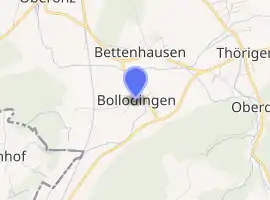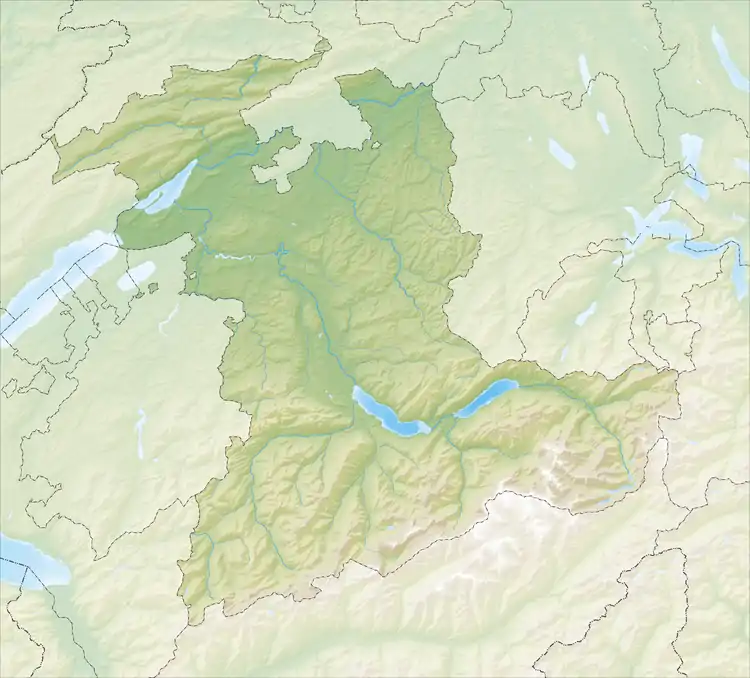Bollodingen
Bollodingen is a former municipality in the Oberaargau administrative district in the canton of Bern in Switzerland. On 1 January 2011 it was merged with the municipality of Bettenhausen.
Bollodingen | |
|---|---|
 Coat of arms | |
Location of Bollodingen 
| |
 Bollodingen  Bollodingen | |
| Coordinates: 47°10′N 7°43′E | |
| Country | Switzerland |
| Canton | Bern |
| District | Oberaargau |
| Area | |
| • Total | 1.92 km2 (0.74 sq mi) |
| Elevation | 476 m (1,562 ft) |
| Population (31 December 2010) | |
| • Total | 205 |
| • Density | 110/km2 (280/sq mi) |
| Time zone | UTC+01:00 (Central European Time) |
| • Summer (DST) | UTC+02:00 (Central European Summer Time) |
| Postal code(s) | 3366 |
| SFOS number | 974 |
| Surrounded by | Bettenhausen, Hermiswil, Oberönz, Ochlenberg, Steinhof (SO), Thörigen |
| Website | www SFSO statistics |
History
Bollodingen is first mentioned in 1266 as Bolathingen.[1]
Geography
Bollodingen has an area, as of 2009, of 1.96 km2 (0.76 sq mi). Of this area, 1.18 km2 (0.46 sq mi) or 60.2% is used for agricultural purposes, while 0.59 km2 (0.23 sq mi) or 30.1% is forested. Of the rest of the land, 0.18 km2 (0.069 sq mi) or 9.2% is settled (buildings or roads), 0.02 km2 (4.9 acres) or 1.0% is either rivers or lakes.[2]
Of the built up area, housing and buildings made up 5.1% and transportation infrastructure made up 4.1%. 30.1% of the total land area is heavily forested. Of the agricultural land, 41.3% is used for growing crops and 18.4% is pastures. All the water in the municipality is in rivers and streams.[2]
The municipality is located in the Önz valley.
Demographics
Bollodingen has a population (as of 31 December 2010) of 205.[3] As of 2007, 3.0% of the population was made up of foreign nationals. Over the last 10 years the population has grown at a rate of 3.6%. Most of the population (as of 2000) speaks German (98.6%), with French being second most common ( 0.9%) and English being third ( 0.5%).
In the 2007 election the most popular party was the SVP which received 52.4% of the vote. The next three most popular parties were the SPS (18.3%), the FDP (9.2%) and the local small left-wing parties (8.2%).
The age distribution of the population (as of 2000) is children and teenagers (0–19 years old) make up 26.4% of the population, while adults (20–64 years old) make up 59.9% and seniors (over 64 years old) make up 13.7%. The entire Swiss population is generally well educated. In Bollodingen about 84.6% of the population (between age 25-64) have completed either non-mandatory upper secondary education or additional higher education (either University or a Fachhochschule).
Bollodingen has an unemployment rate of 0.93%. As of 2005, there were 18 people employed in the primary economic sector and about 8 businesses involved in this sector. 36 people are employed in the secondary sector and there are 3 businesses in this sector. 5 people are employed in the tertiary sector, with 2 businesses in this sector.[4] The historical population is given in the following table:[1]
| year | population |
|---|---|
| 1764 | 172 |
| 1850 | 274 |
| 1900 | 239 |
| 1950 | 236 |
| 2000 | 212 |
References
- Bollodingen in German, French and Italian in the online Historical Dictionary of Switzerland.
- Swiss Federal Statistical Office-Land Use Statistics 2009 data (in German) accessed 25 March 2010
- Swiss Federal Statistical Office - STAT-TAB Archived 2012-04-01 at the Wayback Machine, online database – Datenwürfel für Thema 01.2 - Bevölkerungsstand und -bewegung (in German) accessed 29 September
- Swiss Federal Statistical Office Archived September 4, 2011, at the Wayback Machine accessed 20-Jul-2009
External links
- Bollodingen in German, French and Italian in the online Historical Dictionary of Switzerland.